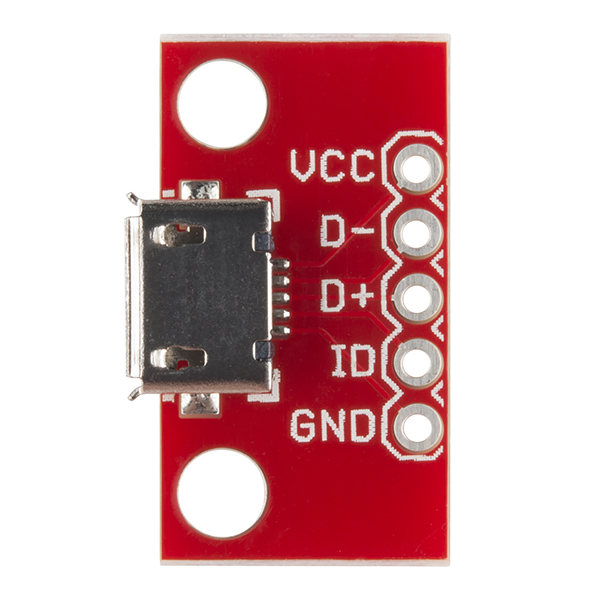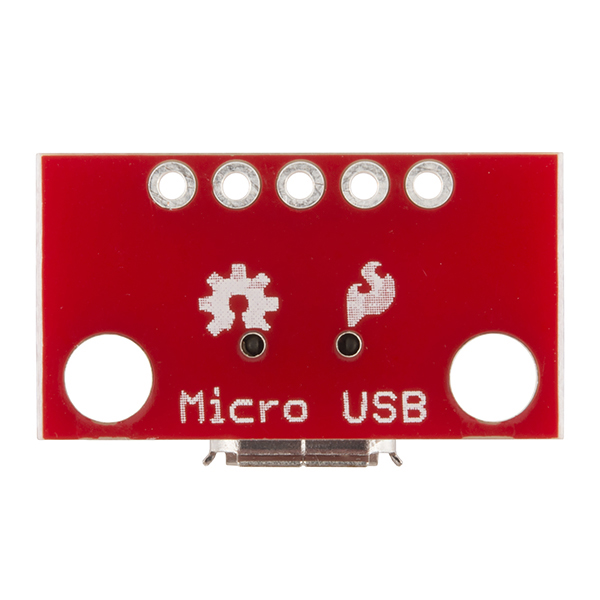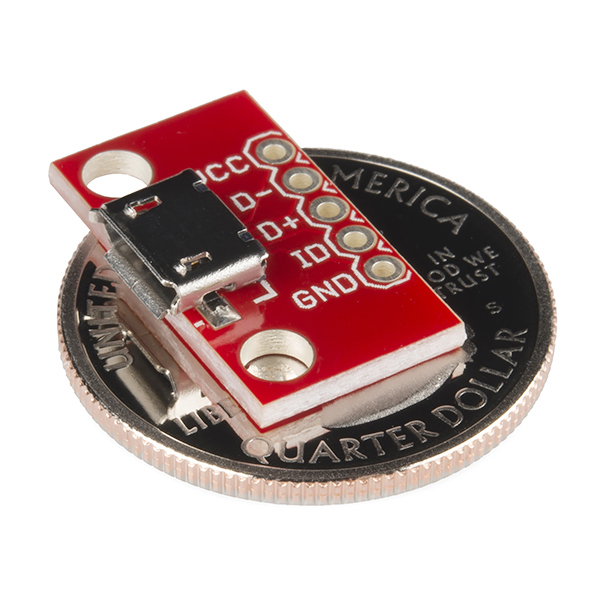SparkFun microB USB Breakout
This simple board breaks out a micro-B USB connector's VCC, GND, ID, D- and D+ pins to a 0.1" pitch header. If you want to add the popular micro-B USB to your project, but don't want to put up with soldering the tiny connector, this is the board for you.
- 0.8 x 0.45" (20.3 x 11.4mm)
- [Schematic](http://cdn.sparkfun.com/datasheets/BreakoutBoards/Breakout Board for USB microB.pdf)
- [Eagle Files](http://cdn.sparkfun.com/datasheets/BreakoutBoards/Breakout Board for USB microB.zip)
- GitHub
SparkFun microB USB Breakout Product Help and Resources
Connector Basics
January 18, 2013
Connectors are a major source of confusion for people just beginning electronics. The number of different options, terms, and names of connectors can make selecting one, or finding the one you need, daunting. This article will help you get a jump on the world of connectors.
Assembly Guide for SparkFun JetBot AI Kit V2.0
March 27, 2020
Assembly Guide for the SparkFun JetBot AI Kit v2.0. This tutorial includes photos & comments to assemble the two-layer chassis & additional components unique to the JetBot kit.
Core Skill: Soldering
This skill defines how difficult the soldering is on a particular product. It might be a couple simple solder joints, or require special reflow tools.
Skill Level: Noob - Some basic soldering is required, but it is limited to a just a few pins, basic through-hole soldering, and couple (if any) polarized components. A basic soldering iron is all you should need.
See all skill levels
Comments
Looking for answers to technical questions?
We welcome your comments and suggestions below. However, if you are looking for solutions to technical questions please see our Technical Assistance page.
Customer Reviews
4.8 out of 5
Based on 12 ratings:
2 of 2 found this helpful:
Wired wrong
3 of the 5 had the +5v on the D+ connector instead of the VCC. Make sure you have a multimeter handy.
Great quality product
I've used for modification of a flysky TH9X station with firmware er9x . I have simplified the connections to the fullest. The product is indicated for the project
Great for cable testing!
I use this for micro-usb cable testing. Plug a loop-back USB-A socket on the far end, and ring out with a DVOM on these solder pads. Good&short cables are only +0.2ohm on the power loop, poor cables can be +1. Also can check data connectivity and ID ohms.
I'd like to have one of these for the Apple Lightening, even though some pins are though actives.
Excellent Breakout! Great for Prototyping!
These are excellent 0.1" spacing breakouts for micro USB-B. I keep a dozen of these near my works station while prototyping for quick plug-and-play action!
Sure makes adding a microB USB easy!
I have struggled soldering to a microB USB and then found it impossible to get it securely fastened to a PC board. This solves those issues.... I did add some epoxy around the connector to make it even more secure to the board... Thanks SparkFun.... great product.
No complaints!
Board worked as expected. A little big, but that just makes it easier to solder to.
It is a good product.
It is well made, durable, and perfect for prototype work.
Exactly as advertised.
If you need a micro USB port for your project, but don't feel like soldering tiny components, then this is just what the doctor ordered.
I'll be buying more in the future.
The first impression is the one that is worth
It's the first time I buy on a website outside of my country, but since my son needed this accessory for a Raspberry project he had to buy it. Buy easily, without problems, the product came to my country and my home without problems and works as expected
Instant 5v Power For Breadboard, Small Footprint
I use this to give myself quick 5v power to my breadboard, using a wall wart adapter and a cable. The breakout board has a small footprint. With just plug it in and there is my power. If you use standard 0.1" pin headers, you might want to place a small pad of something nonconductive like cardboard under the microB connector area, so that the board will not wiggle or move when you connect and disconnect a cable. Something to thicken the board a bit in that area and give me a sense that the board is stable and won't somehow come undone. I am sure the board will become even more convenient when I want to work with USB signals, but for now all I care about are the VCC and GND (power) connections. I will order a few more of these very handy boards.
High Quality
There are cheaper versions of this board online, but they are not nearly as good. This breakout board is high quality and worth every penny. I will be coming back here each time I need more.





Can the metal of the plug come in contact with other metal? I am housing it tightly in a metal box and the metal touches metal.
Hi there, it sounds like you are looking for technical assistance. Please use the link in the banner above, to get started with posting a topic in our forums. Our technical support team will do their best to assist you.
If I remember correctly, the housing is usually tied to the
GNDplane.So Im currently using one of these, connected to a USB solar charger that boasts 5volts / 2.1 amps. Im assuming I just need to power my circuit from the VCC + GND lines, but it doesn't seem to be getting much current at all. (300 milliamps @ 12V, after a step-up regulator, and power mosfet switch). I seem to get 600 ma at least when powering the circuit directly from a 5V power supply.
Do I need any type of digital negotiation before a USB charger will release its full 2.1 AMP?
Thanks.